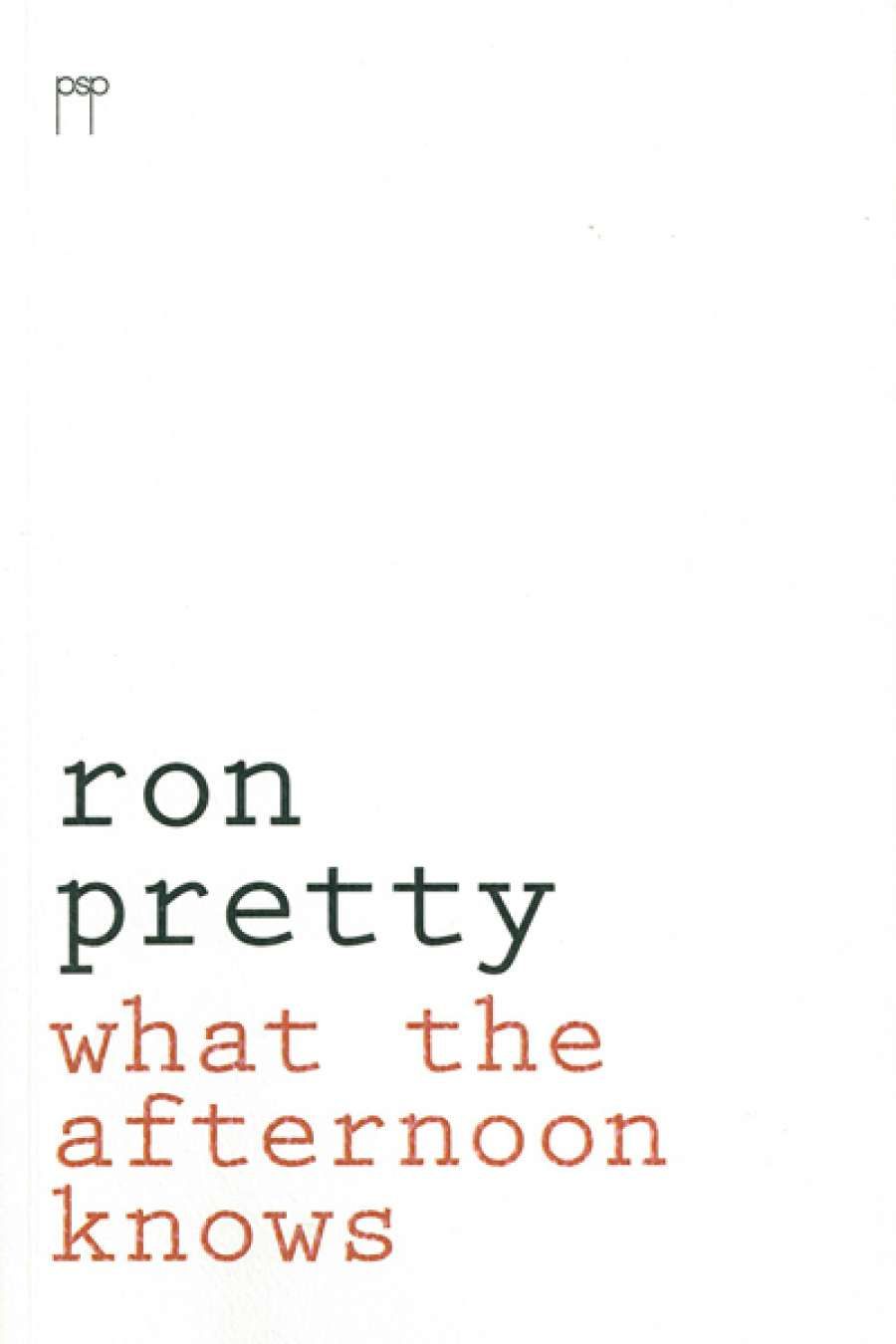
- Free Article: No
- Contents Category: Poetry
- Review Article: Yes
- Article Title: The habit of drift
- Online Only: No
- Custom Highlight Text:
It is reasonable that poets, by the time they reach their mid-seventies, should be involved in projects which re-evaluate their current lives and poems in the light of early experience and expectations. This most recent book of Ron Pretty’s – and it is by some distance his best – is built around the Swedish proverb, ‘The afternoon knows what the morning never suspected,’ treated not as an opportunity to gloat over the wisdom which age is supposed to bring but instead to puzzle out the weird discrepancies and disjunctions between the two states of ‘what-I-was-then’ and ‘what-I-am-now’.
- Book 1 Title: What the Afternoon Knows
- Book 1 Biblio: Pitt Street Poetry, $25 pb, 114 pp, 9781922080165
Two of the poems are specific about Pretty’s sense of the way he has moved from one state to the other. ‘I had / the habit of drift – I have it still,’ he says in a poem otherwise devoted to the precise and troubling issue of the morality of adopting poor children from Third World countries. The book’s final poem, ‘Envoi’, is an exploration, humorous but serious, of this apparent shapelessness in the pattern of his own life, concluding by seeing it as a necessarily fallow time:
So late, that morning shaped my afternoon. I’d never thought what the day might bring; it was enough to endure. Now the sun is inching toward the distant hills, I see that drifting youth and know it was the best of times, an unexamined living with cicadas a long time underground.
If this seems pretty straightforward, the mix is thickened by those poems which explore the way the morning reappears in the afternoon as unexpected memory. Watching a waitress in a Welsh pub in ‘Argini’, the poet recalls a girl he knew in Greece. Nothing came of this – an activist fighting the junta, ‘she was otherwise engaged’ – and we can imagine our author, in one of his drifting moods, presenting the wrong kind of image.
Unexpected memories are one way in which the assumed, orderly flow of time is distorted, and a number of the poems focus on time itself. ‘The Laird of Skaill’ is a fine meditation, imagining the moment of discovery of Skara Brae – the Neolithic settlement on the Orkney island of Mainland abandoned four and a half thousand years ago and miraculously uncovered by a storm in the mid-nineteenth century – by the local laird and focusing on the weird interactions and recurrences of history: just as the original farm was abandoned so is the laird’s manor now.
One of the later poems, ‘The Last Half Hour’, is exactly about the fluidity of time matching how it is experienced subjectively – for lovers ‘every / minute we’ve been given seems a lifetime’ – with how it appears to a geologist or a pope. The last half hour of the poem is both the time of its writing (or, at least, planning) and the scientific populariser’s compression of geologic time into thirty minutes.
‘Being So Caught Up’ is a poem about the usually unconsidered situation of Lazarus (who would want to die twice, for example?). Since it begins with the poet’s surviving a life-saving operation – ‘I think of him as I return from the face of death. / The surgeon with his thin blade, his steady hand / that raises me with its power’ – it seems natural to classify it as a personal poem, but it too deals with time, post-resurrection time in this instance. And the perspective from beyond this end-of-time (in personal, not apocalyptic, terms) is a very distorted and disturbing one.
One always had the feeling from Pretty’s earlier books that his poems were well-made, sturdily braced, hard-working objects that dealt with experience at the personal and social levels but needed an infusion of one kind of madness or another to shake them out of their comfort zone. One of the features that makes What the Afternoon Knows his most satisfying book is that its poems have room for the disturbingly irrational.
Sometimes this appears in the way meditation about memory and time makes the poems dealing with those subjects surprisingly and unsettlingly complex, but the other component is the world of dream. ‘Honi Soit’ and ‘Fool’s Gold’ are two rather different poems which might have their origins in the same dream in which an old man sees three girls paddling in a muddy pool. In the former poem this is teased out into a dramatic monologue focusing on the way dream material is a component of art but ultimately elusive. The latter has the girls of the dream panning for gold and comments: ‘No doubt his analyst – if there were to be one – would make much of the image’.
‘The Emperor of Moths’ is a surreal narrative – presumably dream-inspired – of a voyage into the interior (in both senses) in search of the emperor of the bogong moths, and is both funny and unusual. But the poem which seems to touch on all the major themes of this book is ‘Juliet’, which describes a sleepwalker (a ‘dreamwalking girl’) who experiences the disorientation creatively: ‘The way she knew, she knew, was not the way.’ Since she, like a more famous Juliet, stands ‘on her childhood balcony’, clearly she is one of those whose morning doesn’t give her any clues about what her afternoon will know.


Comments powered by CComment